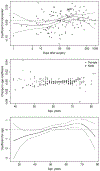Living With Survival Analysis in Orthopedics
- PMID: 33934952
- PMCID: PMC8478706
- DOI: 10.1016/j.arth.2021.04.014
Living With Survival Analysis in Orthopedics
Abstract
Time to event data occur commonly in orthopedics research and require special methods that are often called "survival analysis." These data are complex because both a follow-up time and an event indicator are needed to correctly describe the occurrence of the outcome of interest. Common pitfalls in analyzing time to event data include using methods designed for binary outcomes, failing to check proportional hazards, ignoring competing risks, and introducing immortal time bias by using future information. This article describes the concepts involved in time to event analyses as well as how to avoid common statistical pitfalls. Please visit the followinghttps://youtu.be/QNETrx8B6IUandhttps://youtu.be/8SBoTr9Jy1Qfor videos that explain the highlights of the paper in practical terms.
Keywords: Cox model; censoring; survival analysis; time-to-event analysis; total joint arthroplasty.
Copyright © 2021 Elsevier Inc. All rights reserved.
Figures


References
-
- Kaplan EL, Meier P. Nonparametric estimation from incomplete observations. J Am Stat Assoc 53(457-81), 1958
-
- Murray DW, Carr AJ, Bulstrode C. Survival analysis of joint replacements. J Bone Joint Surg Br 75(5): 697, 1993 - PubMed
Publication types
MeSH terms
Grants and funding
LinkOut - more resources
Full Text Sources
Other Literature Sources

